In this tactical theory piece, we unveil the advantages and disadvantages of a certain attacking strategy on a group tactical level.
As many sides attempt to force the opposition out wide when defending, any team will face the challenge of finding a way to either break through on the wing or to play back into the centre when possessing the ball on either flank.
Wing-play allows for several concepts and strategies to break the opposition defence and create goal-scoring opportunities.
And overlapping and underlapping runs are common and effective concepts when attacking through wide areas.
While the overlapping run is way more popular, underlapping runs hold some advantages that the overlap does not provide.
In our tactical analysis, we examine the anatomy of these runs and explain in their effects on teammates and opposition players in detail.
This will allow you to understand all the pros and cons of the overlap and the underlap.
Definition & aims of overlapping and underlapping runs
To begin with, we have to define the meaning of overlapping or underlapping runs.
In general, either of the two strategies can be described as the forward run of a player from a more defensive position past the ball-carrier into the space behind the opposition defence.
Overlapping and underlapping runs are amongst the most vertical group tactical concepts during the attacking phase and are therewith closely connected with the progression up the pitch and final third actions.
As a result, they are also connected with chance creation. Nevertheless as these runs require space (since the over- or underlapping player needs a free lane for his run) and time (because the over- or underlapping player has to run past the ball-carrier), they are rather executed in wide areas than in the crowded centre of the pitch.
The difference between the overlap and the underlap lies in the path of the run in relation to the ball-carrier.
An overlapping player commits his run on the outside of the ball-carrier and therewith in a wide area.
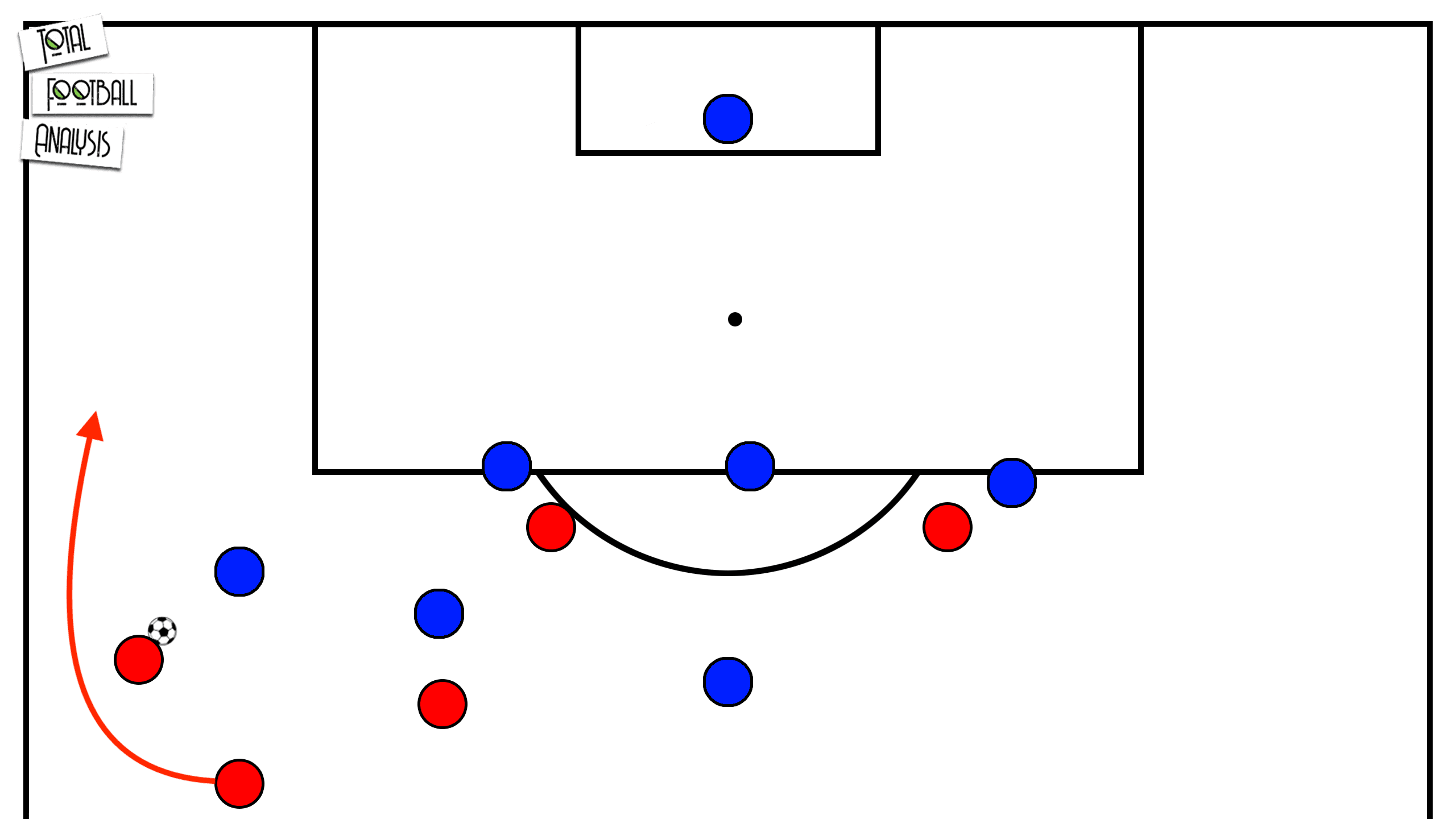
An underlapping player commits the run on the inside of the ball-carrier and therewith in a more central area.
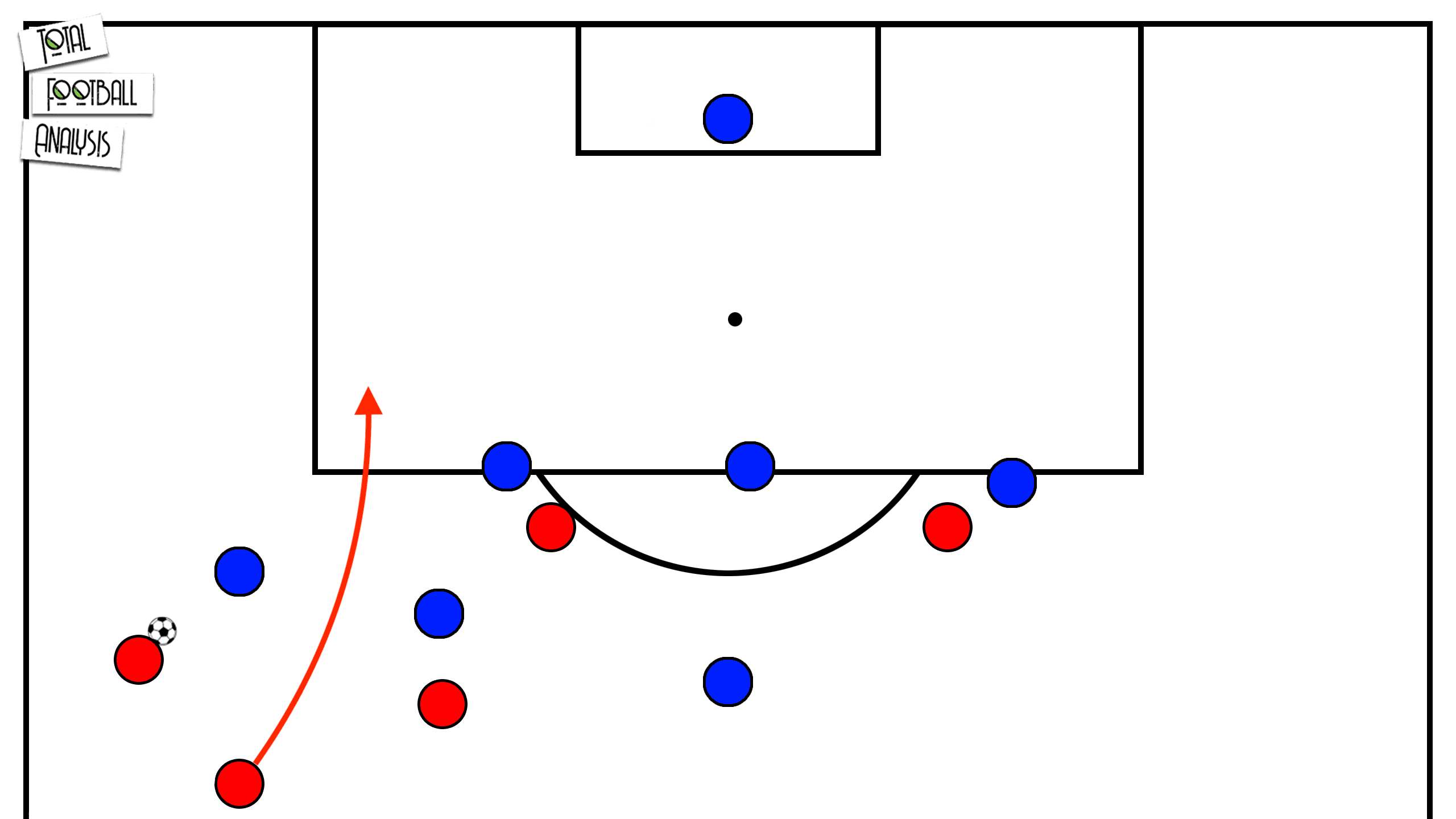
The overall goal of overlaps and underlaps is to achieve on of two things.
Either the runs enable to get behind the opposition defence or they open up space in central areas to play into the half-space or the central channel.
From there, the team has got more attacking options than on the wing, where the passing options are naturally restricted through the touchline.
The group tactical aim behind overlaps and underlaps is to create a numerical advantage.
And overlapping and underlapping runs are a simple yet effective tool to create numerical advantages and overload the opposition full-back.
In addition to that, they offer dynamism and therewith require quick defensive reactions from the opposition.
Dynamic actions decrease the time for the opposition reaction and make the defenders’ decision about his next defensive move more complex.
Also, through the deep run, the space behind the opposition defence can be threatened which often forces the opposition backwards allowing the progression up the pitch.
On an individual level, both the overlap and the underlap affect the positioning and movement of the opposition defender.
Therefore, the run can solely serve as a manipulation instrument enabling the ball-carrier to outplay the defender on the other side.
If the opposition defender does not adjust his positioning, however, the runner becomes a valuable option to overplay the defender.
Overlap or underlap?
As we already defined the overlap and the underlap, we will provide you with a question.
What would you do in the displayed scenario as the full-back of the red team: overlap or underlap?
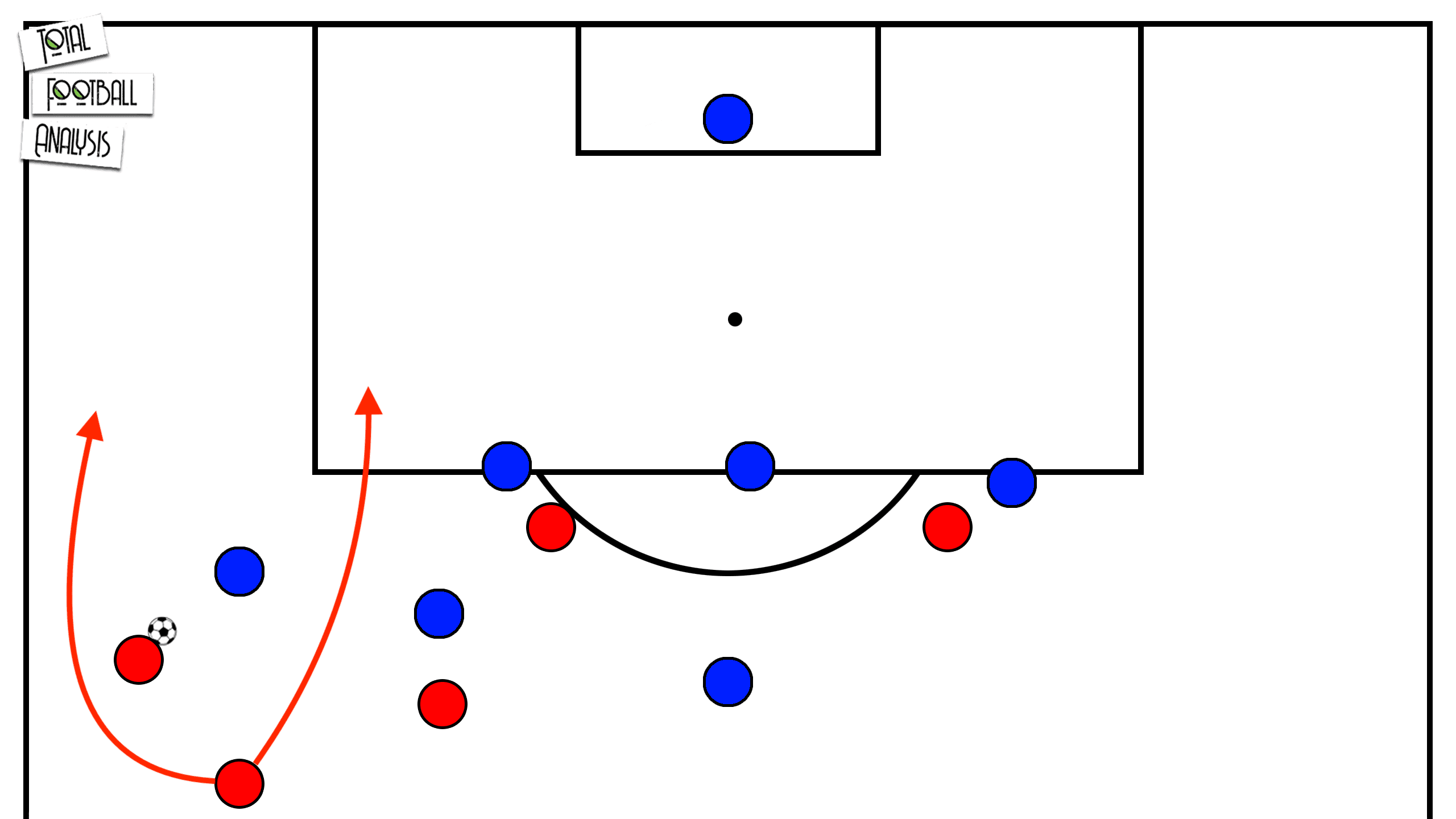
To give you starting points on which you can build your decision, we will discuss several aspects of overlapping and underlapping runs in the following paragraphs.
Systems, positions & strategies facilitating overlapping and underlapping runs
Overlaps and underlaps are often seen when sides deploy systems with two wide players on each side.
This is because these systems already provide the required personnel out wide.
The most common scenario is that a team play with wingers receiving the ball out wide.
Then, the full-back would move up in order to overlap or underlap.
But sides which play with wing-backs as the only wide players and a rather centrally focused attacking approach can also move an additional player out wide once the ball is on the wing in order to create an overlap or underlap.
To sum up, overlaps and underlaps are independent of the system.
The system, however, can affect how these runs are executed.
Most of the times, due to their positioning on the pitch, full-backs commit overlapping runs.
But it does not necessarily have to be a full-back who overlaps.
Sheffield United and Atalanta B.C., for instance, use overlapping centre-backs.
And central midfielders can obviously also move to the wing to overlap although this happens less often.
As underlapping runs are committed in a more central area, often either central midfielders or full-backs will make them.
The latter ones will most often underlap if they stayed in the half-space to cover the attack right before the team switched sides or if they play as inverted full-backs.
The runs are extremely threatening in connection with the concept of “overloading to isolate”.
When overloading one side before switching play to the other side where they isolate the winger against the opposition full-back, an over- or underlapping run can create a 2v1 situation with a lot of space.
If executed well, the opposition full-back can then be outplayed.
In addition to that, overlapping and underlapping runs have proven to be especially useful in combination with the use of inverted wingers.
That is because it facilitates cutting inside when playing with a right-footed left winger or vice-versa.
Therewith, the aim to get into a central area can be achieved.
Advantages and disadvantages of the overlap
As for any tactical concept, the overlap comes with certain advantages but also disadvantages.
One of the most obvious advantages is that the overlapping player has a good pre-orientation as all goal near players are within his field of view.
That can be helpful if teams intend to put in crosses with their overlapping players.
That way, they can already get a clear picture of the available crossing options which can lead to an improved decision-making as the time for perception is increased.
Another advantage is that there is more room in the half-space as the overlapping player does not block any passing lanes within or into the half-space.
That makes it easier for the central midfielders to connect to the wide players.
However, executing an overlapping run also means that the runner attracts an opposition wide player in most scenarios.
As a result the opposition central midfielders can keep their position and shut down the passing lanes into the centre.
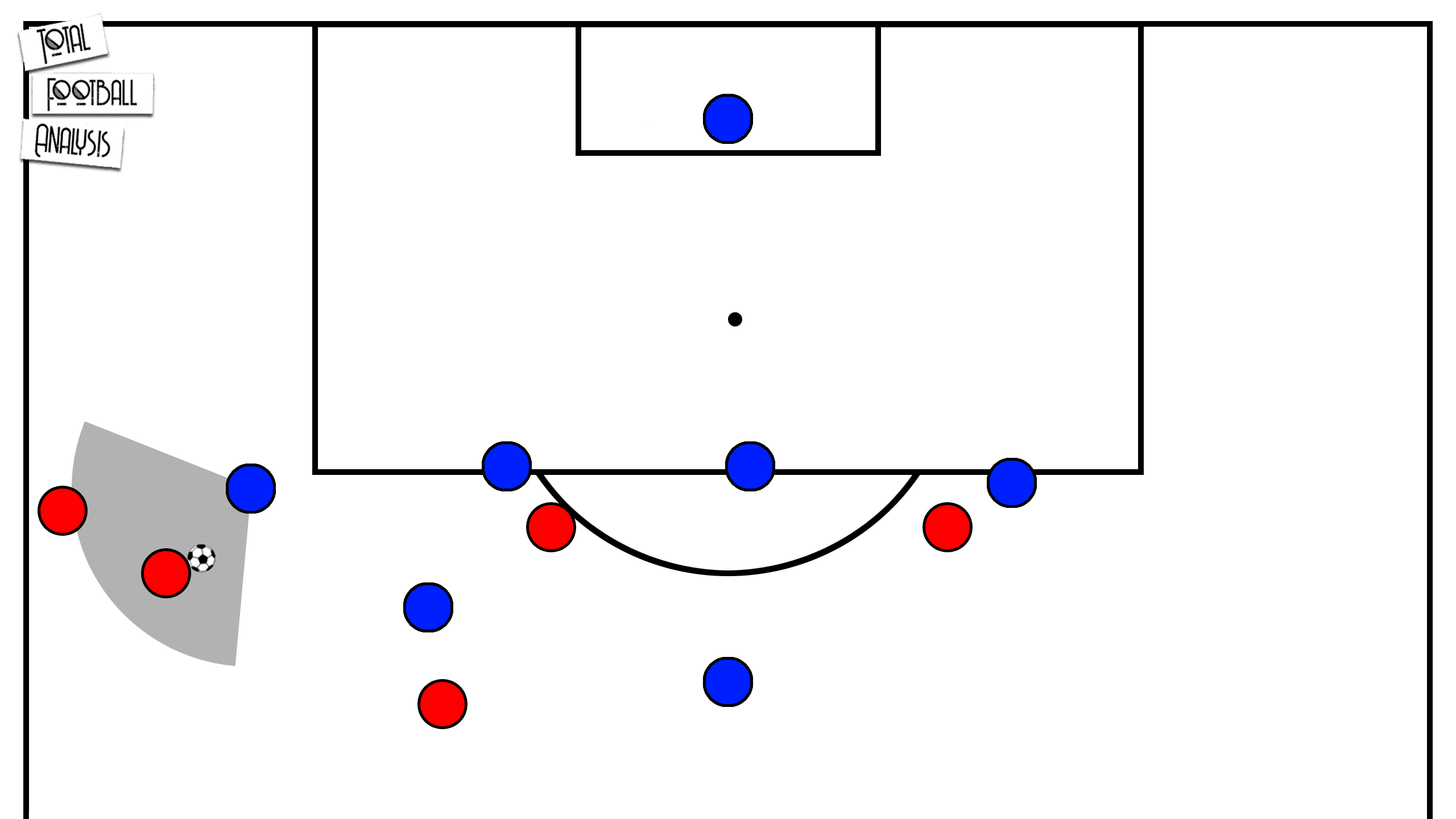
A further negative aspect of the overlap is that the overlapping player is not within the field of view of the ball-carrier while being on full display for the opposition defender.
This facilitates defending and complicates to find the right timing for a possible pass at the same time.
Advantages and disadvantages of the underlap
The pros and cons of the underlap are a bit more complex.
That is because it is executed within the own attacking shape and the defending shape of the opposition.
Instead of running “around” like in the case of the overlap, underlapping players will run through the formations which creates more complex interactions with teammates and opposition players.
Compared to the overlap, the underlapping player is closer the goal (often in the half-space) and therewith takes up a more threatening position.
As a consequence, it is more urgent for the opposition to defend the underlapping player.
This increases the probability of successfully taking an opponent out of play.
Moreover, in contrast to the overlap, mainly affecting the opposition wide players, an underlapping run rather drags an opposition central player out of position.
This possibly opens up a passing lane into the half-space or centre or space to dribble or pass into as shown below.
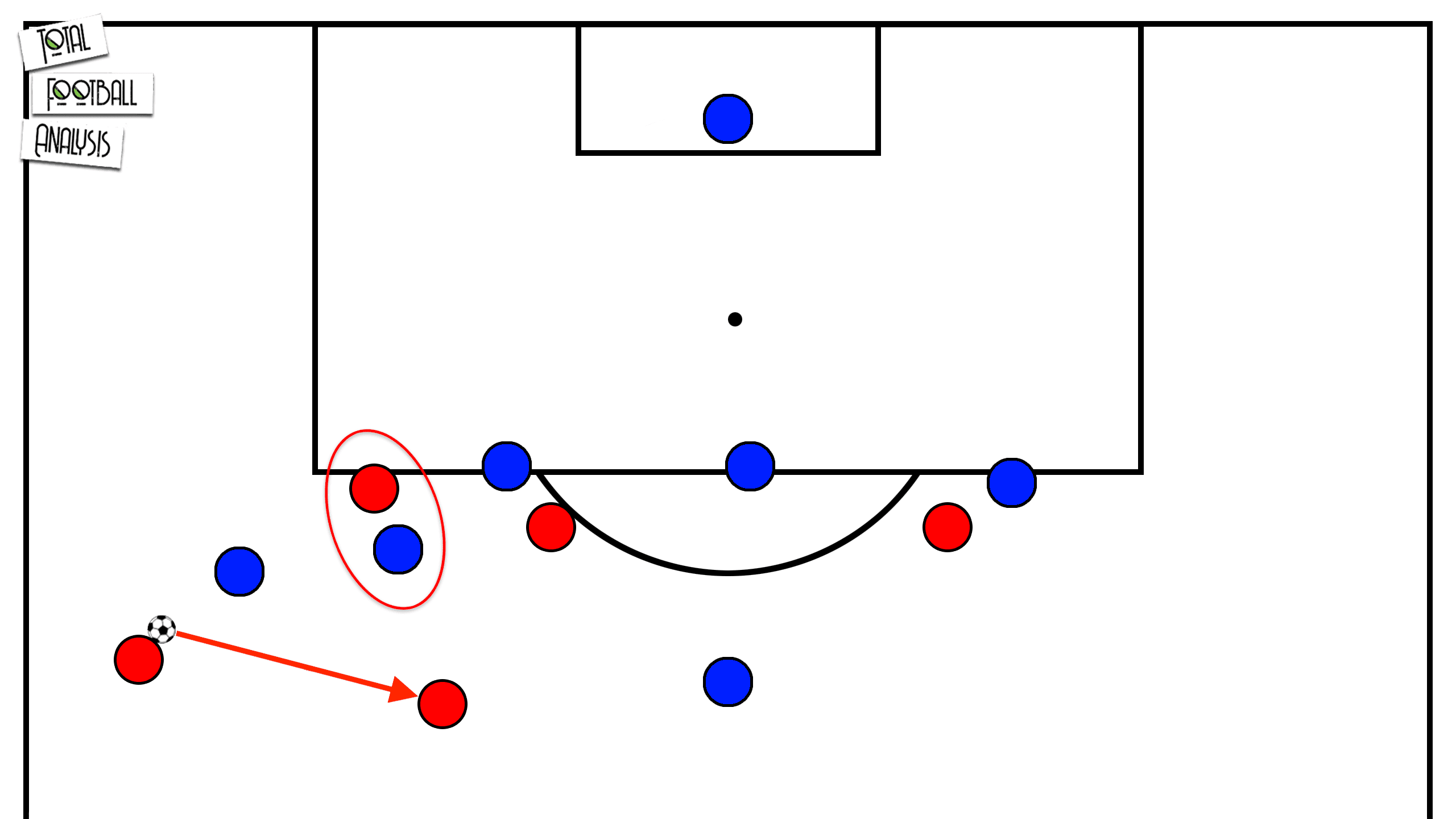
Also, like displayed below, playing the ball to the underlapping player will result in a diagonal pass.
Diagonal passes hold several advantages in football.
In this particular case, it requires the opposition to defend in another channel (the half-space) which therewith not only occupies the wide players but also their centre-backs and central midfielders.
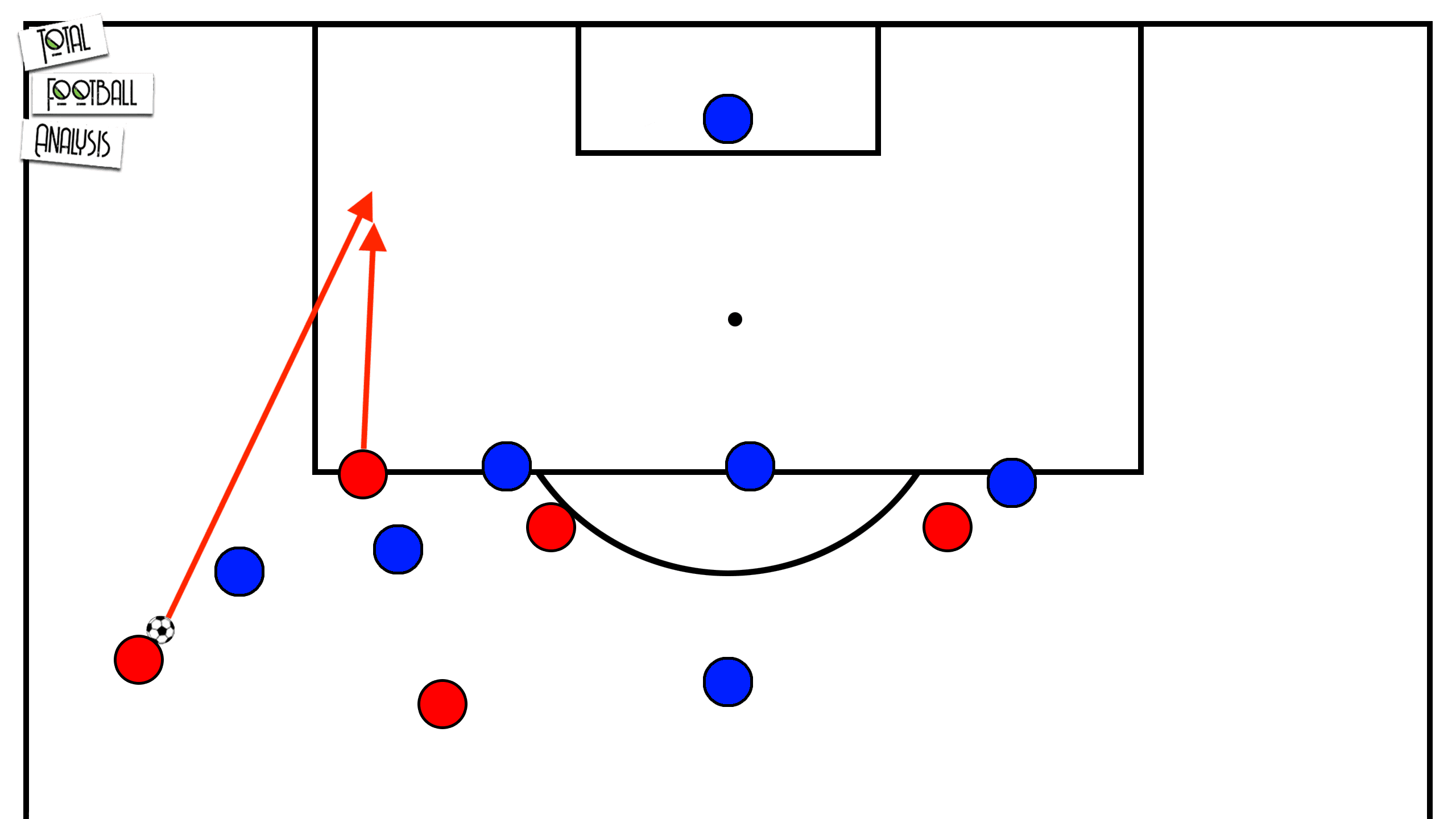
A strong advantage of the underlap compared to the overlap is advantage that the underlapping run is out of the defenders’ field of view.
As a consequence, the defender can only guess the current positioning of the runner which makes it nearly impossible to cut off the passing lane all the time.
Also, it enables the ball-carrier to feint passes due to the disadvantage of the defender not knowing where the underlapping player currently is positioned.
At the same time, the ball-carrier can always see the position of the underlapping player enabling a good timing if he should intend to play a pass.
The field of view concept is also advantageous when dragging an opposition defender out of the position with an underlapping run.
The direct opponent of the ball-carrier confides in his teammate supporting him.
With an underlap, one can drag this teammate out of position without the defender recognising it.
As a consequence, the direct opponent does not change his body shape and an initial ideal positioning can quickly become disadvantageous.
This then enables the ball-carrier to exploit the body shape and positioning in order to dribble into the created space.
But as for any concept, when there are advantages, there will also be disadvantages.
One of those is that the underlapping player intermediately blocks the path into the centre.
This can be seen in the image below.
Even if a central midfielder is free, the runner will cross the passing lane which poses the risk that the ball collides with the underlapping player if a pass should be played into the centre.
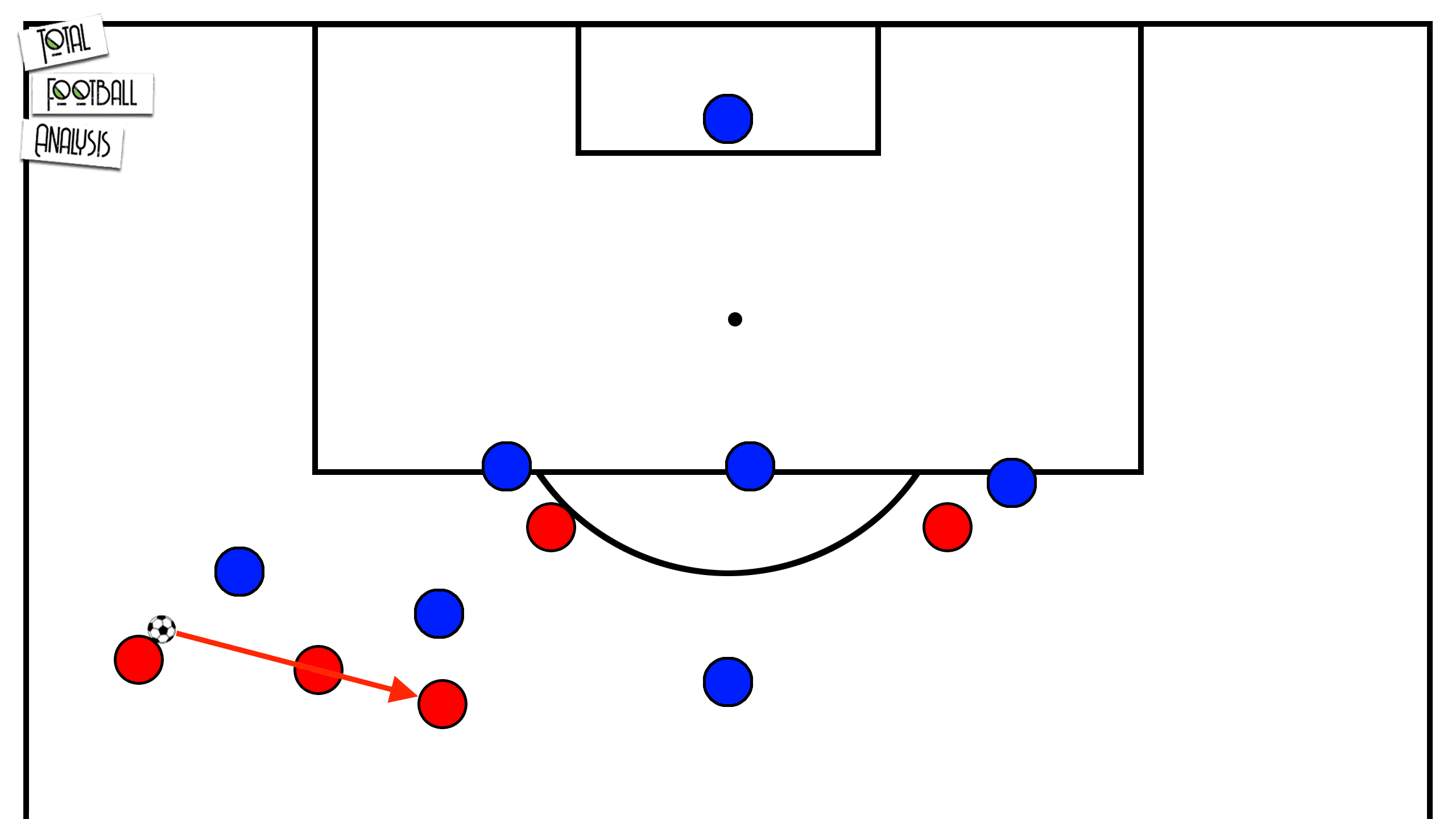
Another negative side effect of the underlap-path is that the underlapping player has a worse pre-orientation when receiving.
He can impossibly focus on both the ball and the situation within the box at the same time.
However, players with good awareness might be able to compensate this.
Furthermore, the runner will intermediately be in the cover-shadow of the defender.
Nevertheless, since the underlap is a dynamic action the period of time within the cover-shadow is comparably short.
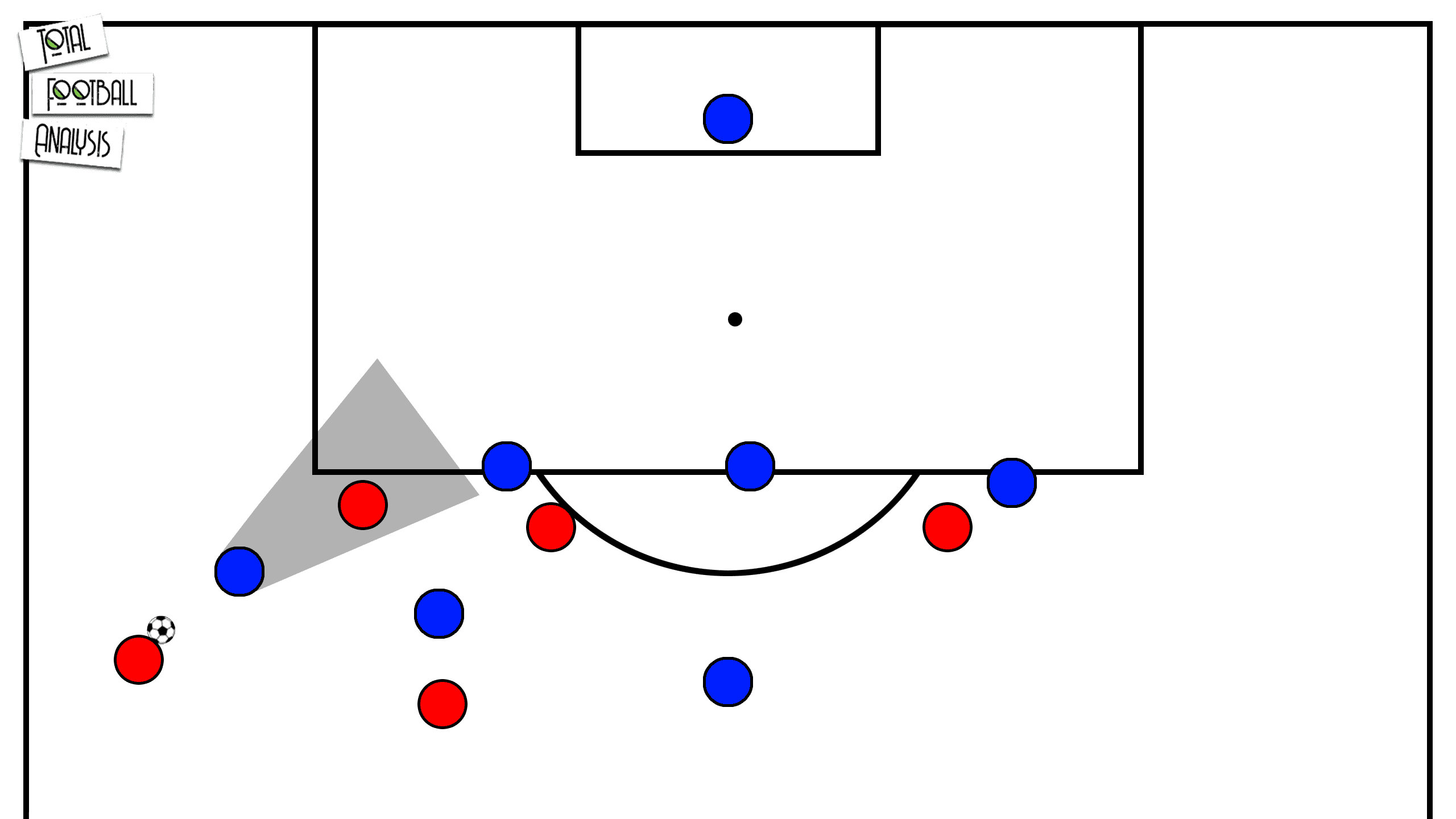
While the overlap is also useful in tight spaces and when the opposition could outnumber the ball-carrier, the underlap is more sensible in situations with available space for the ball-carrier in 1v1 situations.
The reason for that are the described intermediate restrictions the underlap has on the attacking options with the underlapping player blocking passing lanes and being in the cover-shadow.
If the ball-carrier is under pressure and needs an immediate option, the underlap is not as a helpful as the overlap.
Decision-making: Overlap or underlap?
After having examined the advantages and the disadvantages of the overlap and the underlap in detail, we can now come back to the initial question of our tactical theory piece.

Whether it is better to overlap or to underlap in the displayed scenario, depends on several factors that are unknown for us:
- Is the ball-carrier left-footed or right-footed?
- Is the ball-carrier comfortable on the ball?
- Does the ball-carrier usually prefer to stay on the outside or to cut inside?
- Where exactly is the opposition winger (not in the image yet)?
- Does the attacking team prefer crosses or through passes?
The decision when to overlap and when to underlap is too complex to provide a wholesale answer.
As we mentioned in the course of our analysis, overlaps and underlaps are dynamic actions.
They cannot depicted in a still image.
The given scenario still provides reasons for why either an overlapping or an underlapping run is useful.
With an overlap, the opposition full-back would be overloaded and needed to drop closer to the goal.
With the right timing, one could get behind the defence on the flank.
Depending on the opposition, there would probably also be the opportunity for the ball-carrier to cut inside.
With an underlap, on the other hand, there would occur moments when the ball-carrier is isolated in a 1v1 instead of a possible 2v1 as the underlapping player will be in the cover-shadow of the defender or block the passing lane into the centre.
But the underlapping player would probably drag the opposition central midfielder out of his position and therewith open up space for a pass into the centre.
An underlap might increase the chance of penetrating the opposition defence in the half-space instead of on the flank.
Follow-up actions
Highly connected with the above mentioned advantages and disadvantages of overlapping and underlapping runs, they offer several sensible follow-up actions.
At first, we take a closer look at the actions achieving the aim of getting behind the defence.
The most simple pattern would be a pass into the run of the overlapping player who can then send in a cross.
This can be a sensible attacking option for teams which look to score from crosses.
Depending on the position, different crosses can be used to threaten the opposition goal.
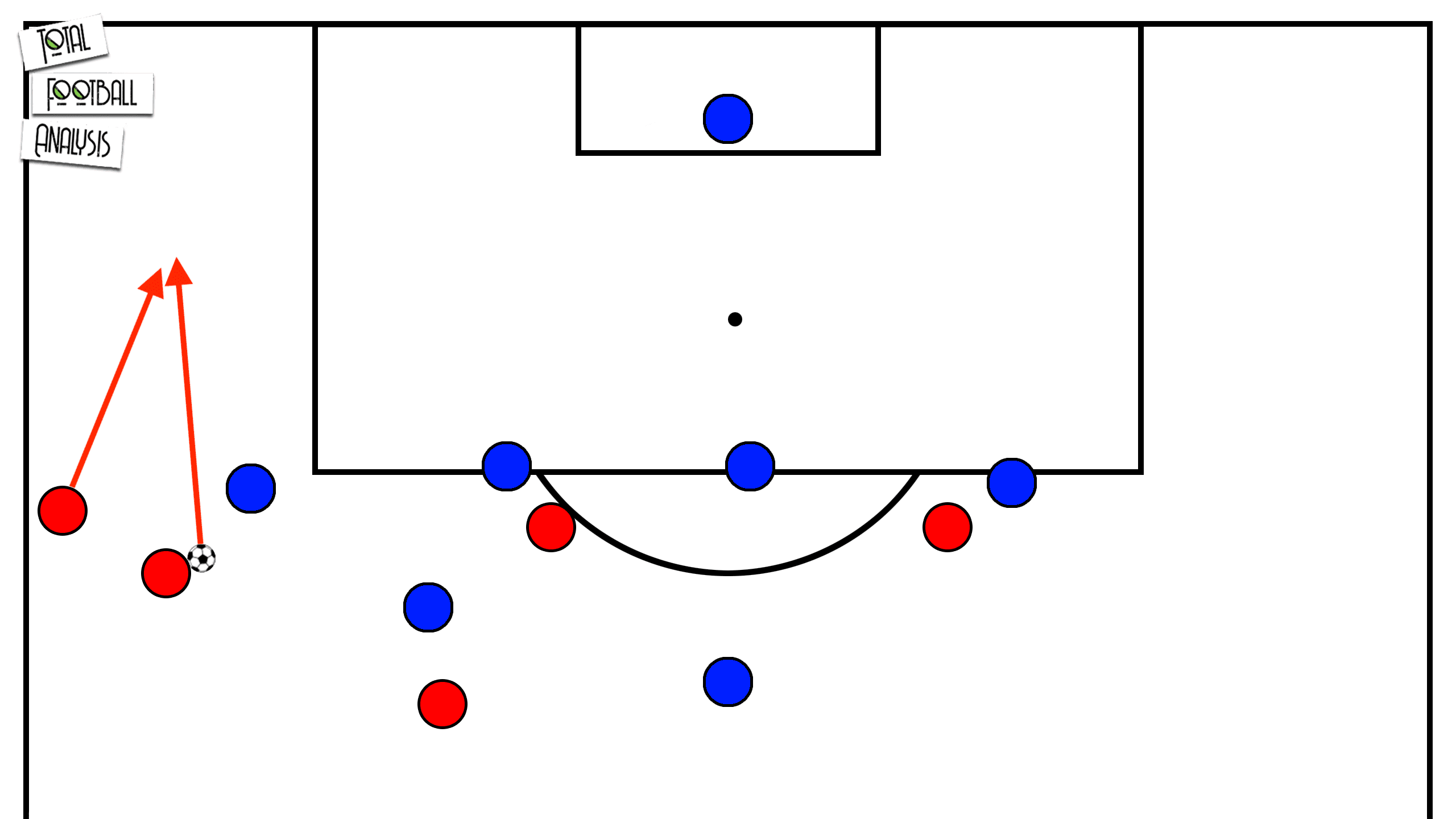
The second option to directly get behind the opposition back line is a pass to an underlapping player.
Due to the different position (closer to the goal) different ways of crosses compared to the overlap are sensible here.
From the half-space, cut back crosses can be extremely dangerous as they do not travel as long as a high cross and allow for more precision when finishing the attack.

The second aim is to escape from the wing and get back into the central channels again which offer a greater variety of attacking options.
In some situations, the ball-carrier can play a pass into a central channel (followed by a switch of play or a penetrating through pass).
Especially the underlap often opens up a passing lane into the centre because the central midfielder is attracted by the runner.
That creates space in a central channel which can then be exploited.
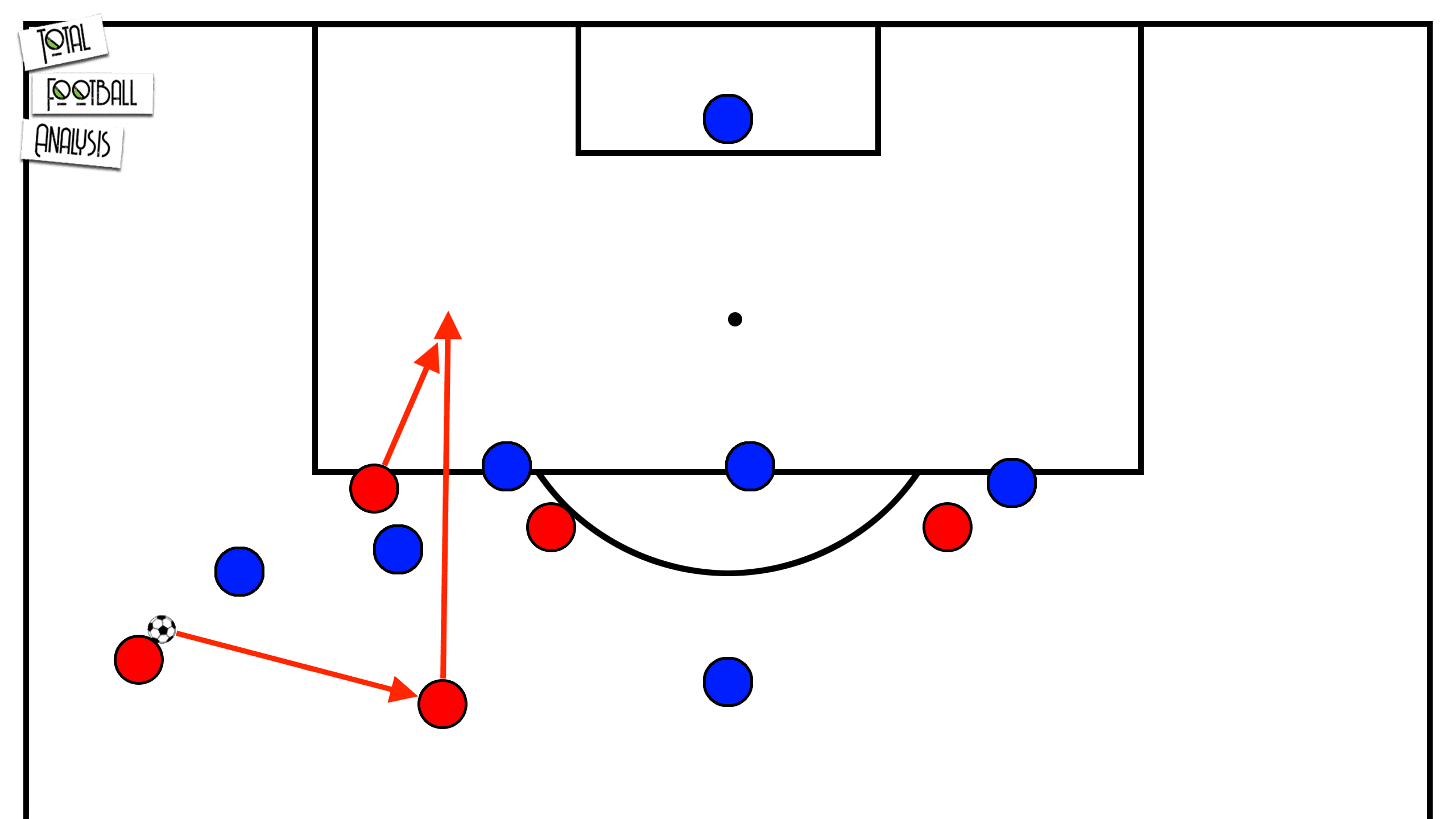
The overlap will probably not drag the central midfielder out of position.
Instead, the opposition might heavily shift towards the wing though, opening up space on the other side which can be exploited after a switch of play.
Last but not least, a very popular scenario is that the ball-carrier cuts inside with a dribbling to either finish, play a through pass or send in a cross into the space behind the defence. This is useful when attacking with inverted wingers like Liverpool.
Their full-backs constantly overlap or underlap.
This manipulates the defenders’ positioning enabling their wingers to carry the ball inside.
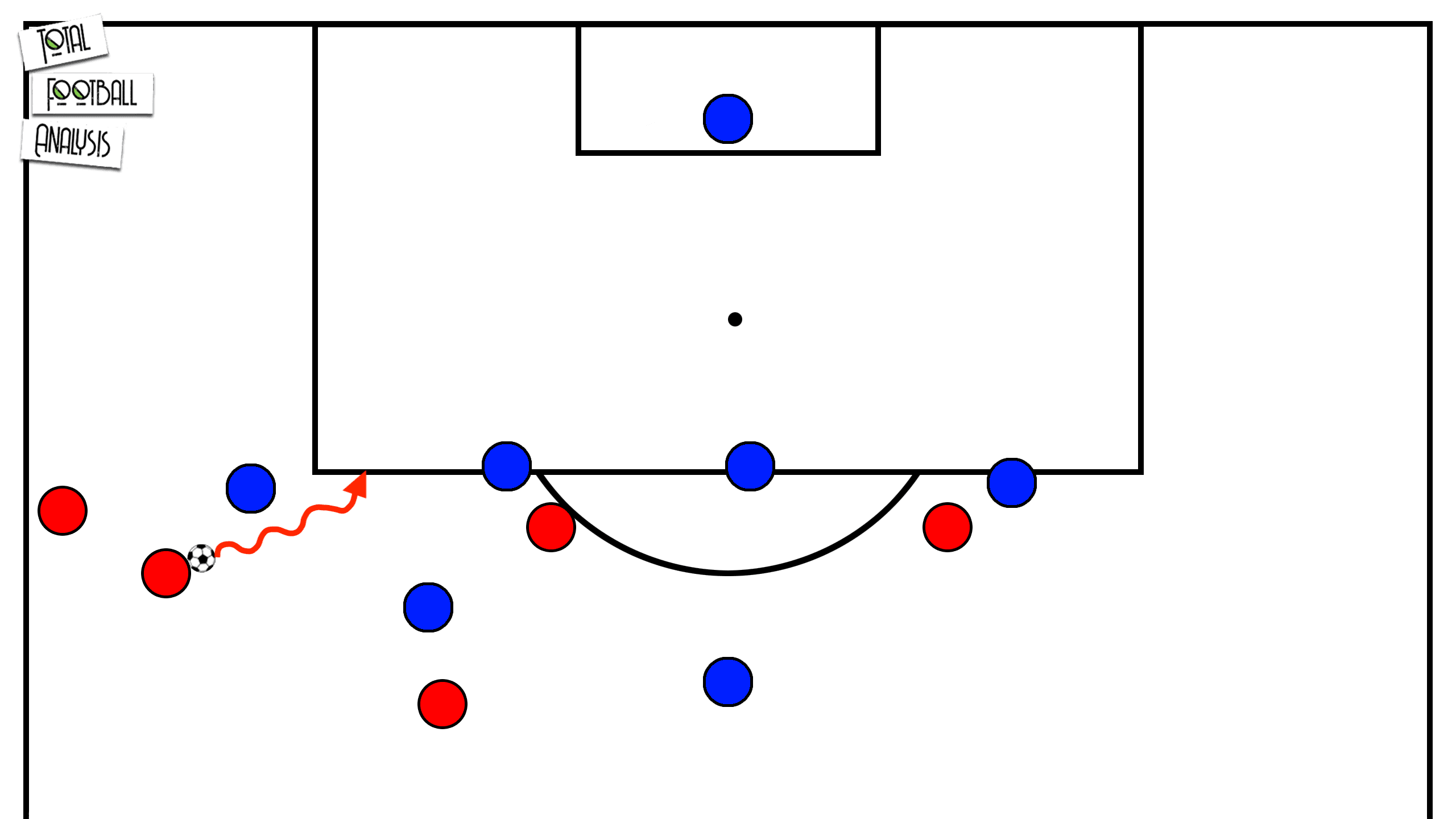
Obviously there are thousands of different follow-up actions.
And since this piece is not supposed to deal with all the different types of crosses, we did not go too much into detail.
Nevertheless, we tried to categorise the most common scenarios to illustrate the possible outcome of overlaps and underlaps.
Conclusion
All in all, both overlapping and underlapping runs are powerful concepts to attract and confuse opposition players and therewith enable the penetration of the opposition defence.
They are dependent on the tactical system provided
In our analysis, we unveiled that especially the underlapping but also the overlapping run hold a lot of advantages.
Taking this into account, it seems that their still is room for improvement and more sides could focus on underlaps instead of executing overlaps only.
Nevertheless, varying between overlaps und underlaps, depending on the space available and the numerical situation, might be the most promising strategy as it presents the opposition with different challenges.
Therewith, overlapping and underlapping runs can pose a huge weapon as a part of the attacking tactics during wing attacks.





Comments